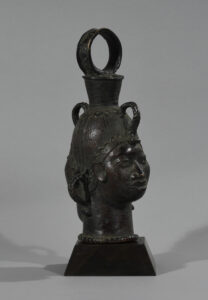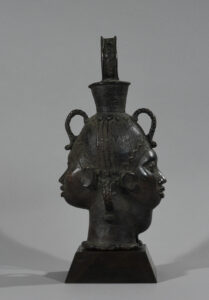ANK 0517-10
Ife bronze ‘Janus bronze sculpture’ shaped like a vase, Yoruba, Nigeria
This beautifully decorated ‘Janus bronze sculpture’ shaped like a vase depicts the faces of two beautiful young girls. Their hair is neatly arranged in many small braids and headbands. This unusually and stunningly beautiful bronze sculpture originates from the small West African kingdom of Ife, which was founded in the 13th century deep in the West African rainforests and belongs to Yoruba, which is still the largest people in Nigeria. Ife kingdom not to be confused with the later and greater Kingdom of Benin, located 256 miles or 412 miles to the east. This sculpture is most likely portraits of two princesses. They may be twins and belongs among other things because of the size of the most valuable figures that it has exhibited inside the royal palace among the other royal family members.
It is sculptures like this that count among some of the earliest naturalistic expressions of people in the world, which were also significant prior to the European Renaissance and even today are among humanity’s greatest artistic achievements and come from a crucial time in the development of West African artistic traditions and technological innovation.
Furthermore, the casting technique is extremely high. Ife metalworks are considered the finest in the ancient world; their sophistication – casting is only a few millimeters thick – was not seen in the West until the 19th century. The figure was made using the relatively raw method of ‘lost-vax- casting’ (cire perdue in French). The figure was originally carved in vax and then encapsulated in a clay shape. Then, make a small hole in the clay and the mold is then laid on a fire or in an oven, so that the wax melts and runs out. Then pour the liquid metal (bronze) into the holes which then replaces the wax. Finally, the mold is broken. Hence the term “waste mold casting” or “lost-wax casting,” because the mold is destroyed.
This sculpture is unique because most other cultures are not able to make it particularly thin in shape, and this to capture fine, delicate surface details. Early European explorers were so amazed at the fineness of these pieces that they refused to believe that African peoples had created them despite the “classic” African features depicted in all cases. Similar figures were observed on an altar in Ife’s royal palace and are believed to represent members of Obalufon II, the first king of Ife, who is said to have introduced the art of metal casting to his people.
Measure: H: 35, W: 17, D: 17 cm – weight: 2.45 kilos
Age: Est. beg. to mid. 20th Century
Condition: All in all, it is a perfectly cast antique sculpture that appears with a beautiful gray-brown bronze in beautiful condition. Except for a smaller ‘notch’ at the bottom of the figure.
Provenience: Acquired from a Brussels art dealer ex private Belgian collection.
Literature:
Request price for Ife Bronze





